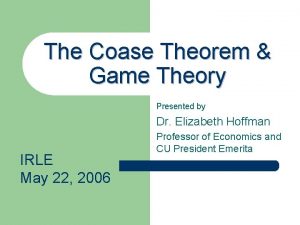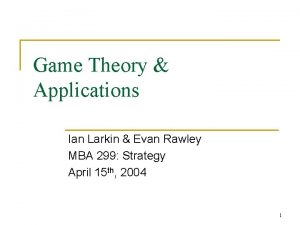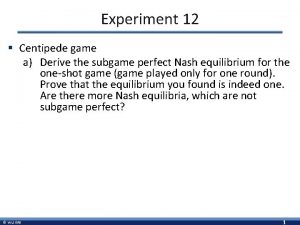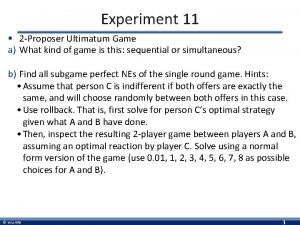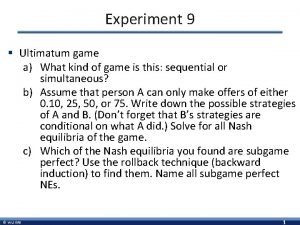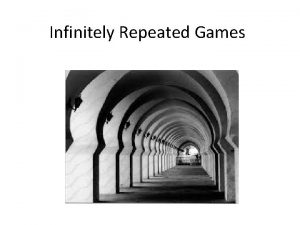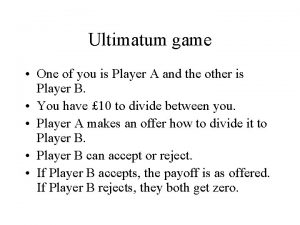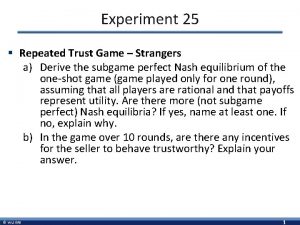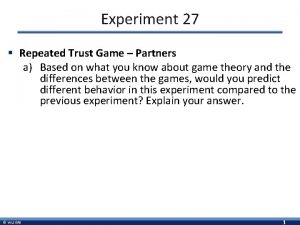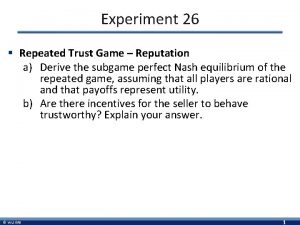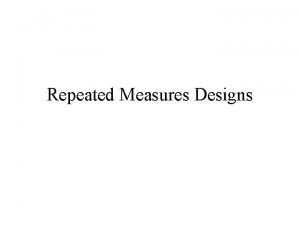Experiment 10 Repeated Ultimatum game a Find the














- Slides: 14

Experiment 10 § Repeated Ultimatum game a) Find the subgame perfect NE of the 10 -times repeated game using rollback. © WU IMS 1

Experiment 10 § The subgame perfect Nash equilibrium (SPNE) of the repeated game (repeated with the same players) corresponds to playing the one-shot SPNE in each repetition. § Why? Backward induction! • In the very last repetition, i. e. last proposal, last response, what is the SPNE of the game? • The unique one-shot SPNE! That means, behavior in the very last round is completely independent of any behavior before. • Thus, in the second-to-last round, as behavior has no impact on how players will behave in the last round, the game is again played like the one-shot game. • The same is true for the third-to-last round, etc. , until we arrive at the first round. © WU IMS 2

Experiment 10 § Subgame perfect Nash equilibrium (SPNE) of the repeated game: • Proposer: Offer minimum amount in each round. • Responder: Accept any amount (larger than zero) in each round. © WU IMS 3

Finitely repeated games § Theorem: • If a game G has a unique subgame perfect Nash equilibrium, then there exists a unique subgame perfect Nash equilibrium in the finitely repeated game G(T) in which the subgame perfect Nash equilibrium of the game G is played in each repetition. • Proof: We find the SPNE of the T times repeated game by rollback. The SPNE solution for the last repetition T will be the SPNE of the one-shot game. So play in the second-to-last repetition T-1 cannot change what comes after in T. As a result, the SPNE solution for the second-to-last repetition T-1 will also be the SPNE of the one-shot game. Etc. etc. until the first repetition. © WU IMS 4

Finitely repeated games: Example 10 § Extensive Form of UG repeated twice 10 A Offer x 1 A accept Offer x 2 0. 01 10 accept A Offer x 2 (10 -x 1+10 -x 2 , x 1+x 2) B reject 0. 01 accept (10 -x 1+ 0 , x 1+0) ( 0 + 10 -x 2 , 0+x 2) B reject ( 0 + 0 , 0+0) 0. 01 Solve backwards © WU IMS 5

Finitely repeated games: Example 10 § Extensive Form of UG repeated twice 10 A Offer x 1 Subgame 3 accept A accept Offer x 2 0. 01 10 Subgame 2 accept A Offer x 2 (10 -x 1+10 -x 2 , x 1+x 2) B reject 0. 01 Subgame 1 (10 -x 1+ 0 , x 1+0) ( 0 + 10 -x 2 , 0+x 2) B reject ( 0 + 0 , 0+0) 0. 01 § SPNE solution in SG 1 and SG 2 will be exactly the same (here: x 2=0. 01, accept all). § Solution in SG 1 and SG 2 does not depend on what happened before in SG 3. © WU IMS 6

Finitely repeated games: Example § Extensive Form of UG repeated twice 10 A Offer x 1 Subgame 3 accept B (10 -x 1+SG 1_payoff , x 1+ SG 1_payoff) with SG 1 payoffs equal to SG 2 payoffs! reject 0. 01 ( 0 + SG 2_payoff , 0+ SG 2_payoff) § SPNE solution in SG 1 and SG 2 will be exactly the same (here: x 2=0. 01, accept all). § Solution in SG 1 and SG 2 does not depend on what happened before in SG 3. § Solution in SG 3 will be exactly like solution of one-shot game with no SG 1/ SG 2 afterwards. © WU IMS 7

Finitely repeated games § Theorem: • If a game G has a unique subgame perfect Nash equilibrium, then there exists a unique subgame perfect Nash equilibrium in the finitely repeated game G(T) in which the subgame perfect Nash equilibrium of the game G is played in each repetition. • Proof: We find the SPNE of the T times repeated game by rollback. The SPNE solution for the last repetition T will be the SPNE of the one-shot game. So play in the second-to-last repetition T-1 cannot change what comes after in T. As a result, the SPNE solution for the second-to-last repetition T-1 will also be the SPNE of the one-shot game. Etc. etc. until the first repetition. © WU IMS 8

Finitely repeated games § Note: • If a game has only one NE, then this must be the unique SPNE of the game. • So when repeating the game, playing this NE in each repetition is the only SPNE of the repeated game. © WU IMS 9

Experiment 10 § Data b) Analyze the data set of experiment 10. Describe the behavioral pattern you observe. Is there a change in behavior over time, in the different rounds? © WU IMS 10

Share of all offers Experiment 10 Avg: 3. 99 offer © WU IMS 11

Experiment 10 © WU IMS 12

Experiment 10 © WU IMS 13

Share of all offers Experiment 10 Avg: 3. 08 (/10) Avg: 3. 99 offer © WU IMS 14



